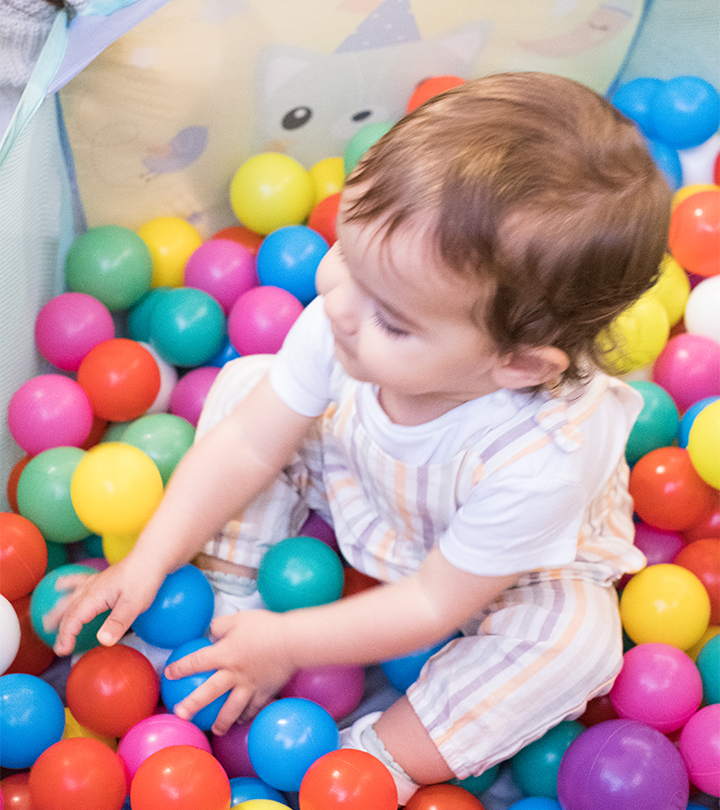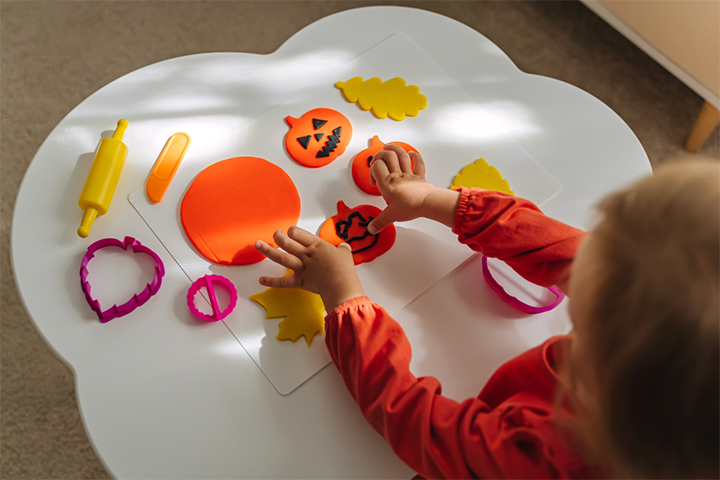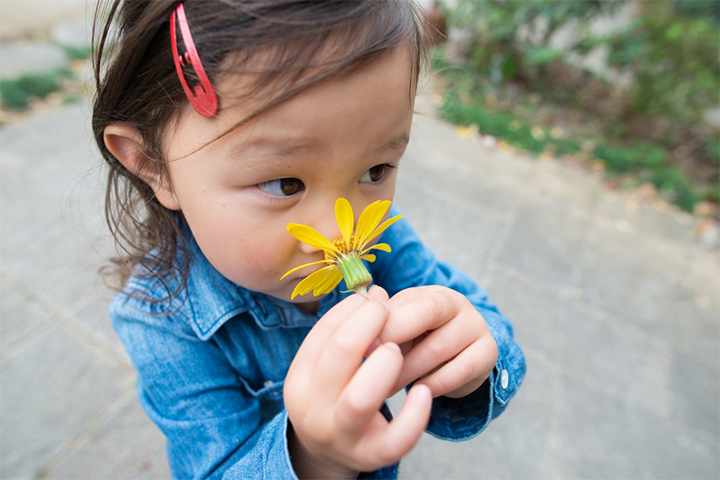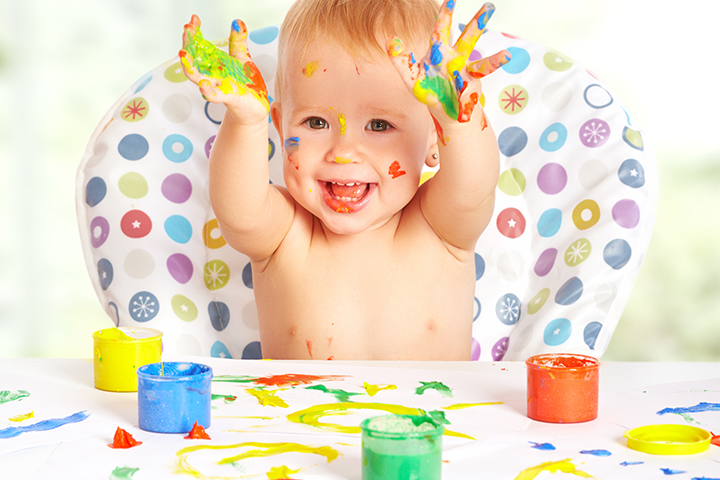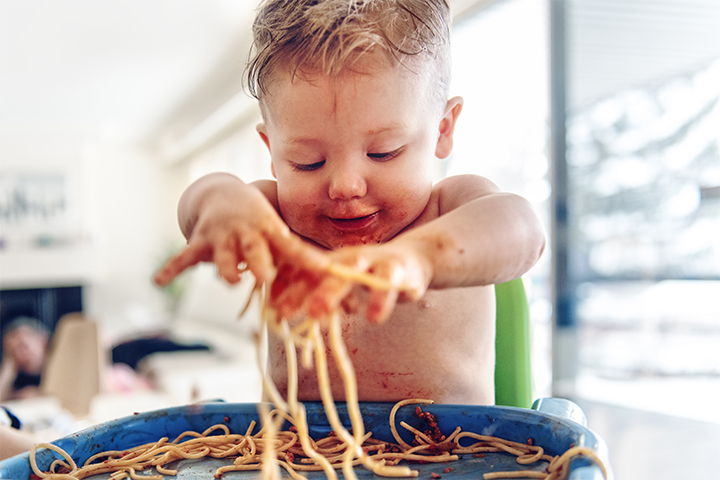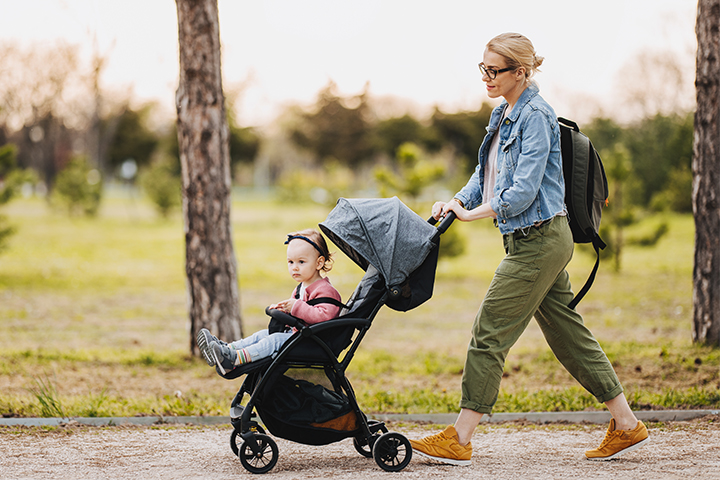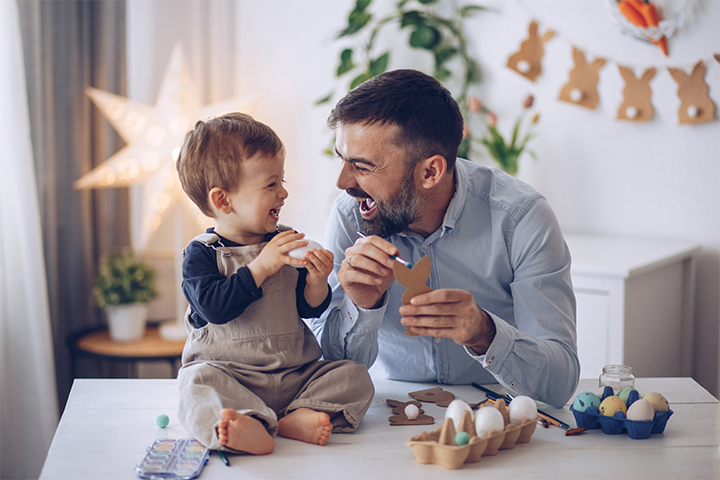As a parent, you want to provide your baby with a fun and stimulating environment to help them grow and develop. Sensory activities for a 1-year-old are a great way to do just that. These activities are designed to engage and stimulate their five senses – touch, taste, smell, hearing, and sight. Babies are exposed to a vast array of stimuli from their surroundings, and their developing nervous system must be able to sort and process all of this information effectively. The ability to process sensory information is crucial for their overall development, impacting their motor skills, social-emotional growth, and learning. These activities provide a structured and controlled environment for babies to explore and learn about their senses, thus improving their sensory processing abilities. As a result, babies can strengthen their sensory system by participating in these activities, leading to improved cognitive and motor development (1).
Benefits Of Sensory Activities For A One-Year-Old
Sensory activities can be simple and aid in promoting a baby’s development. Babies often start attempting to complete tasks independently as their cognitive capacities mature. At this age, your baby has probably started crawling or has even made attempts to walk. Sensory development is vital for a child because it helps them learn how to interact with the environment around them, as well as learn how to ‘regulate’ or calm their nervous system. Let’s look at a few benefits of sensory activities for your one-year-olds.
- Fine motor skills: These activities help to strengthen the baby’s hand and finger muscles, promoting the development of fine motor skills, such as grasping and manipulating objects.
- Cognitive development: Sensory activities can promote cognitive development by engaging the baby’s brain and encouraging problem-solving and critical-thinking skills (2).
- Sensory development:Sensory play activities may assist babies with touch, smell, and engaging with textures by providing hands-on exploration opportunities.
- Socializing: Sensory activities can also support social-emotional development by providing opportunities for the baby to interact with others, build trust, and make bonds.
- Encourages exploration: By providing different textures, smells, and sounds, sensory activities encourage the baby to explore and discover the world around them, promoting their overall development.
- Strengthens sensory system: Through repetitive exposure to various stimuli, sensory activities help to strengthen the baby’s sensory processing abilities, leading to improved motor skills and cognitive development.
Sensory Play Activities For One-Year-Olds
Sensory activities are a fun and engaging way to support a baby’s development. However, it is important to choose appropriate activities for the baby’s age and always supervise them while they are engaged in sensory play, as they are still prone to mouthing objects. Here is a list of sensory activities for 1-year-olds that can be easily set up at home. So, let’s get started and let your little one discover the world through their senses!
1. Box of exploration
Put tiny objects in transparent plastic boxes. Cover and seal them tight. Now offer these boxes to the baby to inspect and shake them, stimulating their sense of touch and curiosity.
2. Stuffed animal petting zoo
Place various textured stuffed animals for the baby to touch and feel. You can include dogs, cats, birds, or any stuffed animal they love.
3. Canvas painting
Pick up a canvas at your neighborhood craft store, smear it with various colors of child-safe paint, wrap it with plastic wrap, and let them use their fingers to create a masterpiece.
4. Sensory bin
Fill a container with rice, beans, cereal, or pasta for the baby to explore and play with.
5. Youg-art
Fill a plate with yogurt and spread it evenly. Now let your baby use carrot sticks to draw patterns on it.
6. Sound composers
Use a cardboard box for this activity. Wrap a few elastic bands on it and let your toddler play it as a harp.
7. Sort the balls
Fill a bowl with ping pong balls of three different colors. Now ask your baby to separate each set into three different bowls.
8. Self-portrait
Get a printout of your baby’s photo and hang it on the wall. Ask them to locate their facial features and name them on the photo.
9. Box tunnels
Do not throw away the big cardboard boxes. Instead, use them as tunnels and ask your baby to pass through them.
10. Playdough
You can use playdough to provide a soft, squishy material for the baby to explore. Rolling, squeezing, and moulding may offer an interesting sensory experience to your baby. You can also hide their toys inside and let the baby find them.
11. Textured blanket
Use blankets in different textures for the baby to explore and touch. For example, you can use a blanket made of soft fur, velvet, satin, or even corduroy.
12. Sorting pom poms
Get large multicolored pom poms. Ask your little one to sort these pom poms colorwise.
13. Colorful bottles
Grab a couple of bottles, fill them with water and add different food colors. Now place them next to a window, and let the sunlight bring out the colors in each bottle. Capture your baby’s expression while they see the colors!
14. Straws in a container
Create openings in a box’s lid and demonstrate to your toddler how to put straws through the lid.
15. Ice tub
Fill a tub with ice. Then, use a spray bottle filled with warm water to demonstrate to your child how ice melts.
16. Bathing toys
Place some toys in the bathtub and let your baby give them a bath like you bathe your little one.
Charu Goswami, a mother, describes how she transforms bath time into a sensory experience for her one-year-old daughter, H. She shares, “H loves water ever since she was born. So, whenever we get a chance or over the weekend when dad’s home, I leave the two for a sensory bath. All that you need for that is a bath tub and some objects with different textures like her favorite rubber ducky, some straws, ice cream sticks, napkin etc. The warm bath is not only soothing but works as a great activity to stimulate baby’s senses (i).”
17. Scooping cooked rice
Give them a spoon and encourage them to scoop out rice in a container or a plate.
18. Tower of paper towels
Let your baby play with paper towels by stacking them on top of one another, building a tower.
19. Mirror play
Make your baby sit in front of a mirror and let them play with their reflection.
20. Coconut snow
For places where you don’t experience snowfall, you may shred coconut and let your baby pretend to play and experience snow.
21. Whipped cream painting
Spray some whipped cream on a tray and let your toddler use their fingers to have fun drawing patterns.
22. Jingle bell play
Jingle bell sensory play is a fun activity for a one-year-old baby that can help to stimulate their sense of hearing and develop their fine motor skills. This activity involves giving the baby a set of jingle bells or similar small, noise-making toys and encouraging them to play with them.
23. Rice or pasta play
Pour different types of pasta or rice. Now let your baby touch and play with it to encourage tactile exploration.
24. Surprise box
You may buy a surprise box or make a customized one for your baby. All you require is a box that has been cut open and is empty. Hide your baby’s favorite toys in the box and let them explore them.
25. Bathtub art
Place your baby in the bathtub. Give them child-friendly washable colors and help them unleash their creativity.
26. Finger and toe counting
Though early, try and teach your baby how to count using their toes and fingers; you can also recite baby rhymes that include numbers while doing so.
27. Block construction
Help your one-year-old to play and explore with blocks and create different shapes and structures.
28. Color sort the Skittles
Place the Skittles in a tray and help your little one sort them colorwise. Be careful they don’t eat them.
29. Neighborhood watchers
Sit next to the window with your baby and observe what’s going on in the neighborhood. Talk to the baby about what you see through the window.
30. Magnet magic
Put a few small magnetic items in the tub and conceal the opening of the tub tightly. Let your toddler then move each item in the tub using a magnet.
31. Sensory ball pool
Fill a tub with colorful balls of different colors, sizes, and textures. Let your baby have a fun time playing in the pool.
32. Dangling loofahs
Grab a few loofahs, and thread them together. Then clip them from a tabletop in a dangling motion. Now let your baby play with these swinging loofahs.
33. Drums using buckets
Your child will enjoy banging on makeshift drums as you tip over some buckets or tubs of various sizes. Add singing and dancing to the beats and record your baby’s reaction!
34. Playing with vegetable peels
Why throw away the peels when they can make for a fun sensory activity? Place vegetable peels in a plastic container and let your baby explore them by touching, smelling, and tasting them.
35. Walk in the garden
Take your child for a stroll in the garden so they can feel the grass under their bare feet.
36. Explore the kitchen
Put away the items in the kitchen that are unsafe for your toddler, and then let them explore the kitchen and various utensils.
37. Kitchen music fest
Hand them some spoons and encourage them to create a fun musical beat while they are exploring the kitchen.
38. Animal dumb charades
Show your kid some pictures of various animals while you imitate their sounds and behavior. Allow your baby to point at the images and identify the animals.
39. Halloween sensory bag
Try this fun autumn game. Work together to remove the insides of a pumpkin. Rather than throwing the pulp and seeds away, put them in a sensory bag and let your baby enjoy touching them and shaking the bag.
40. Tickle time
Watch your baby giggle nonstop as you gently tickle them. You can also use your camera to record these fun moments.
41. Sponge and water games
Working on hand strength by squeezing the sponge is quite effective. This is another interpretation of water play.
42. Mystery lunchbox
Children enjoy opening and closing containers. To give your kid a sensory experience, place their favorite snack options inside the box. Make sure the containers are easy to open and will not cause harm to their delicate fingers. Encourage your child by clapping whenever they get to their treats.
43. Phonograph easter eggs
Create an aural sense-stimulating gizmo using some leftover Easter eggs. Put anything you have on hand in it—coins, paperclips, beans—and tape it closed. Toddlers may sway and create music.
44. Paper play
Give your baby some unimportant papers and watch them crush, tear, or just play with the textures. Maintain a close watch on them because they can try to swallow the paper.
45. Nature stroll
Go for a stroll in nature. Give your baby some dry leaves and flowers to touch, hold, and enjoy while watching the birds. Pointing to things and introducing them to the child may encourage them to speak.
46. Snowman bottle
Draw the facial features of a snowman in two transparent bottles and ask your toddler to stuff the bottle with cotton balls.
47. Pull a ribbon
Grab an Oball and fill it with faux ribbons. Now let your baby pull and play with them across the house.
48. Bubble foam
Bubble foam sensory play can help your baby explore and engage with foam, a soft, squishy substance made from a combination of soap and water. Babies get to experience the texture, consistency, and sensation of the foam.
49. Sensory balloons
Fill some colorful balloons with water, salt, or sand. Tie them up securely. Watch your toddler play as they try to grasp and feel these balloons.
50. Peek-a-boo
Peek-a-Boo is a sensory play activity for babies where a parent covers their face with a blanket or hands and says “peek-a-boo,” then reveals their face with a smile. This can help stimulate a baby’s senses of sight, sound, and touch
51. Retrieving toys
You can attach your child’s favorite toys to a table or a wall with painter’s tape. Now let your babies retrieve using their pincer grip.
52. Plastic egg play
Your baby can have fun trying to disassemble and stack plastic Easter eggs.
53. Cup towers
Watch your child knock down and reconstruct the plastic cup towers that you have made.
54. Whisker paint
Whisker paint is an engaging activity for one-year-old babies that helps to enhance their fine motor skills and sense of touch. This activity involves making a paint-like substance by mixing baby-safe ingredients such as yogurt or oatmeal with food coloring. Then paint it on any surface, such as a piece of paper or a tray.
55. Rainstick play
Rainstick play is a sensory activity that is designed to engage a baby’s sense of hearing. A rainstick is a musical instrument that makes a gentle rain-like sound when turned or shaken. The activity involves giving the baby a rainstick and encouraging them to play with it.
56. Finger painting
Put baby-safe paint in bowls and guide your baby to dip their fingers in the paint and make patterns on a piece of paper with their fingers. Supervise them so that they do not ingest any paint.
57. Sticky wall art
Cover a portion of a wall with paper if you wish to protect your wall. Give your baby colorful stickers or colored sticky tape to stick on the wall. Alternatively, you can cut out particular shapes or patterns (e.g., leaves or flowers) from sticky tape and let your baby paste them on the wall.
58. Solving puzzles
Purchase age-appropriate puzzles and guide your baby in solving them. You may buy big sized puzzle pieces made from wood or plastic for your baby. Sit with your baby and have a good bonding time.
Sensory activities are a fun and engaging way to stimulate a one-year-old baby’s senses and promote their development. These activities are designed to promote the baby’s sensory, motor, and can be a great way to bond with them while helping them learn about their environment. Whether it’s playing with jingle bells, whisker paint, or a rainstick, there are a variety of sensory activities that can be tailored to your baby’s age and interests. With a little bit of creativity and supervision, you can create a fun and safe sensory environment for your baby that will help them thrive and grow.
Key Pointers
- Sensory play aids in the development of gross and fine motor skills.
- Babies may find it simpler to interact with textures, smells, and touch with sensory play activities.
- During sensory play, ensure parents or guardians are always present to supervise the babies.
Fun and engaging sensory and motor skills activities for your 1 year old! Learn how to keep your little one entertained indoors with these activities.
